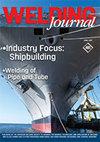Power Density Distributions in Electron Beams
IF 1.4
3区 材料科学
Q2 METALLURGY & METALLURGICAL ENGINEERING
引用次数: 1
Abstract
Measuring and controlling the power density distribution of electron beams used for welding is critical for producing repeatable welds and for transferring welding parameters between different machines. On any given machine, the power density distribution is controlled by defocusing the beam relative to its sharpest focused condition. However, measuring the power density distribution can be difficult due to the intense nature of welding beams and is further complicated by imperfect electron optics that can distort the beam, making it difficult to quantify. The enhanced modified Faraday cup (EMFC) diagnostic method was used here for beam analysis that utilizes computed tomography to reconstruct the beam’s power density distribution. These results were compared to the International Standards Organization (ISO) method for characterizing laser beams using a second-moment D4σ calculation. For ideal Gaussian-shaped beams, both methods would give the same result. However, for imperfect beams, the calculated D4σ diameter was shown to be about 25% larger relative to the FWe2 diameter measured by the EMFC due to the heavier weighting of data in the tails of the beam by D4σ. Although both methods produce repeatable welds, it is important to understand the differences in the reported beam diameters, divergence angles, and beam parameter products when transferring parameters between machines.电子束中的功率密度分布
测量和控制用于焊接的电子束的功率密度分布对于产生可重复焊接和在不同机器之间传递焊接参数至关重要。在任何给定的机器上,功率密度分布是通过光束相对于其最锐利聚焦条件的散焦来控制的。然而,由于焊接光束的强烈性质,测量功率密度分布可能很困难,并且由于不完美的电子光学器件会使光束扭曲,使其难以量化,从而进一步复杂化。本文使用增强改良法拉第杯(EMFC)诊断方法进行光束分析,利用计算机断层扫描重建光束的功率密度分布。这些结果与国际标准组织(ISO)使用二阶矩D4σ计算表征激光束的方法进行了比较。对于理想的高斯形光束,两种方法都会得到相同的结果。然而,对于不完全光束,计算得到的D4σ直径比EMFC测量到的FWe2直径大25%左右,这是由于光束尾部数据的D4σ权重更大。虽然这两种方法都能产生可重复的焊缝,但在机器之间传递参数时,了解所报告的光束直径、发散角和光束参数产品的差异是很重要的。
本文章由计算机程序翻译,如有差异,请以英文原文为准。
求助全文
约1分钟内获得全文
求助全文
来源期刊

Welding Journal
工程技术-冶金工程
CiteScore
3.00
自引率
0.00%
发文量
23
审稿时长
3 months
期刊介绍:
The Welding Journal has been published continually since 1922 — an unmatched link to all issues and advancements concerning metal fabrication and construction.
Each month the Welding Journal delivers news of the welding and metal fabricating industry. Stay informed on the latest products, trends, technology and events via in-depth articles, full-color photos and illustrations, and timely, cost-saving advice. Also featured are articles and supplements on related activities, such as testing and inspection, maintenance and repair, design, training, personal safety, and brazing and soldering.
 求助内容:
求助内容: 应助结果提醒方式:
应助结果提醒方式:


